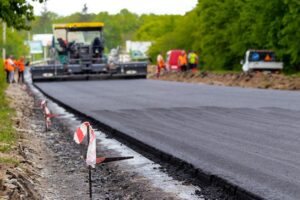From Blueprint to Reality: How Infrastructure Development Services are Shaping the World
Are you tired of bumpy roads, power outages, and slow internet connections? Well, thank the stars for infrastructure development services! These services provide essential support for the structures and systems that keep our daily lives running smoothly.
Infrastructure development services include planning, design, construction, and maintenance of various public works such as roads, bridges, power grids, water systems, and more. They have a rich history dating back to ancient civilizations when construction of basic infrastructure was considered a priority. Nowadays, with rapid urbanization and population growth, they are more important than ever.
Infrastructure development services not only enhance our quality of life but also support the economy. Improved infrastructure attracts domestic and foreign investment, creates jobs locally, and boosts economic growth. With the ever-increasing need for sustainable development, infrastructure development services ensure environmentally friendly infrastructure systems that reduce carbon footprint and promote green infrastructure and renewable energy.
In short, infrastructure development services are the backbone of society, and our world would be a vastly different place without them.
The role of infrastructure development services in economic growth
Infrastructure development services play a crucial role in economic growth by addressing the infrastructure deficit, attracting foreign investment, and creating jobs and boosting local economies. Infrastructure is the backbone of any economy, and without it, businesses cannot operate efficiently, and growth is hindered.
For instance, poor roads and inadequate power supply hinder transportation and production processes, hence reducing their output. However, with adequate infrastructure, companies can easily access markets and transportation facilities. As a result, businesses thrive, leading to more job creation, increased productivity, and ultimately, economic growth.
Infrastructure development services provide a reliable investment opportunity for foreign investors looking to expand their markets. Developing countries with inadequate infrastructure can benefit from foreign investment, which can be used to improve their facilities, leading to increased economic growth.
The development of infrastructure leads to increased economic activities, leading to more job creation and an improved standard of living. For example, road construction projects can create jobs for people like engineers, construction workers, and road maintenance staff. Infrastructure development services, therefore, play a crucial role in ensuring a healthy economy.
Sustainable infrastructure: A key focus for infrastructure development services
Environmental sustainability has become one of the biggest challenges of our time. Understanding this, infrastructure development services have focused on sustainable development practices that aim to protect the planet while meeting the increasing demand for infrastructure. Such practices include conducting environmental and social impact assessments to ensure that infrastructure projects are carried out in a responsible manner. These assessments also help to identify potential negative impacts on the environment and local communities, which can then be mitigated.
Moreover, infrastructure development services also recognize the importance of green infrastructure and renewable energy sources. As more and more of the world’s population moves into cities, green infrastructure such as parks, green roofs, and urban forests can help to mitigate the impact of urbanization on the environment by reducing the urban heat island effect and improving air quality. Renewable energy sources like solar and wind power offer a clean and sustainable alternative to fossil fuels.
Reducing carbon footprint is yet another focus area of sustainable infrastructure development. With the threat of climate change looming large, infrastructure development services are increasingly looking at ways to reduce greenhouse gas emissions from infrastructure projects. One way to do this is by adopting low-carbon construction techniques and materials, like recycled materials, which can lower the carbon footprint of a project.
Sustainable infrastructure development is critical for the survival of our planet. By focusing on sustainable development practices, infrastructure development services can help to ensure that our infrastructure needs are met while protecting the planet for future generations.
Technology and innovation in infrastructure development services
Technology and innovation have revolutionized the way infrastructure development services operate. Smart city solutions are changing the way cities are planned and managed. With IoT, data can be collected and analyzed in real-time, making it easier to identify and address issues. Imagine walking on a street, and the streetlights turn on automatically as you walk past them, and the traffic signals work in harmony with the flow of traffic.
Advanced materials and construction techniques make buildings safer, more sustainable, and long-lasting. Modern-day structures are designed to withstand natural disasters and reduce carbon footprint. Recently, a company claims to have successfully 3D printed a house in 24 hours; imagine the possibilities.
Despite these possibilities, technology and innovation pose challenges to infrastructure development services. The adoption of new technologies requires high capital expenditures, which could pose a financial risk. But with partnerships between the private and public sectors, these risks can be mitigated while the benefits are shared.
In conclusion, technology and innovation have played a crucial role in reshaping infrastructure development services. Innovations such as Smart city solutions, IoT, and Advanced materials have created sustainable and safer environments. While the adoption of new technologies poses challenges, effective public-private partnerships can help to mitigate risks and encourage innovation to thrive.
Challenges and opportunities for infrastructure development services
Let’s face it, infrastructure development services face a lot of challenges. Funding and financing continue to be a perennial issue, with many projects failing to get off the ground due to a lack of investment. On top of this, policy and regulatory frameworks can be complex and difficult to navigate, making it tough for developers to get the go-ahead for their plans.
Public-private partnerships can be a double-edged sword. On one hand, they can provide the necessary funds and expertise to get projects moving. On the other hand, they can lead to conflicts of interest and disagreements over project goals.
Regional and geopolitical considerations are also important factors to keep in mind. Infrastructure projects can have a significant impact on local communities and the environment. It’s imperative that developers take a nuanced approach, listening to local voices and ensuring that projects are sustainable over the long term.
But despite these challenges, there are plenty of opportunities for infrastructure development services. With the right funding and support, they have the potential to revolutionize the way we live, work and travel. It’s an exciting time to be involved in this field, and we can’t wait to see what the future holds.
Case studies: Infrastructure development services in action
Infrastructure development services are not just talk; they are a reality. China is at the forefront of this with its high-speed rail, connecting cities like Beijing and Shanghai in no time. Meanwhile, Germany is leading the charge in renewable energy, utilizing wind turbines and solar panels to power entire cities. And in South Korea, smart city solutions are the norm with trash cans that send notifications when they’re full and public transport integration at its finest. It’s amazing to witness how infrastructure is reshaping the world.
Conclusion
As we conclude this blog, let’s recap the key takeaways:
Infrastructure development services play a vital role in spurring economic growth, sustainable development, and technological advancements. Sustainability and innovation are top priorities for the future of infrastructure development services. Challenges such as funding, regulatory frameworks, and geopolitical considerations need to be addressed for successful implementation.
The future of infrastructure development services is promising, with more emphasis on green infrastructure, smart city solutions, and digitalization.
Let’s keep our blueprints ready and turn them into reality with sustainable, innovative, and inclusive infrastructure development services. After all, a better tomorrow starts with better infrastructure today.



